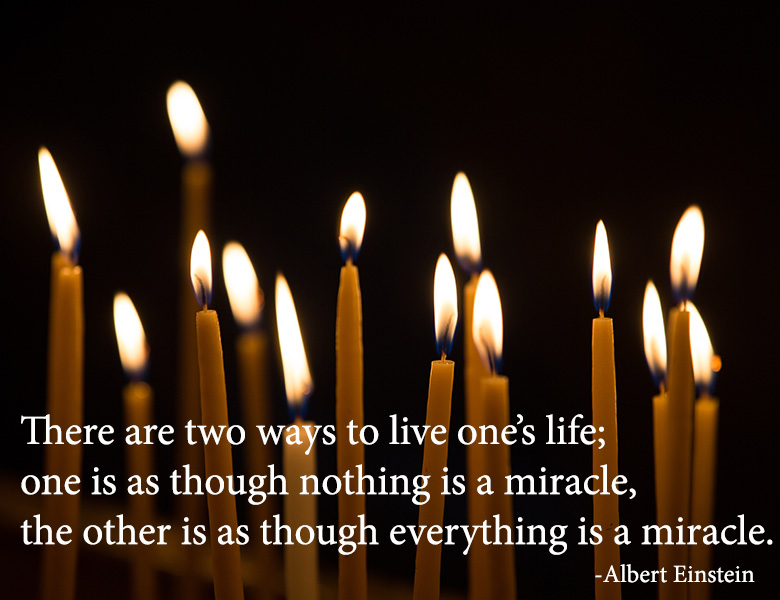5 Keys to Creating Your Life As If It Really Mattered
by Robert “Dusty” Staub, best selling author of The 7 Acts of Courage.
Do you live your life as though everything is a miracle, or as though nothing is?
Einstein was right on point about our perception of “what is.” HOW you set your mind to see the world is one of the most powerful ways to bring change into your life. The larger your frame of reference, the more likely you are to be a transformative force in this world, someone who can make “shift” happen.
To help you do this I suggest you play with, if not outright embrace, the idea that everything around you is a miracle. This shift in consciousness opens the “doors of perception,” leading to a more creative and innovative way of understanding yourself, those around you, your world and your work in this world. It makes the world both more accessible and engaging, allowing new insights into richer possibilities and more enabling choices.
The first two parts of this series looked at the power and the necessity of letting go in order to live in a more transformative way. As highlighted in Part Two, doing this requires all eight (8) Acts of Courage.
In this post, we’ll talk about 5 powerful HOW TO’s around living and leading in more creative, potent and effective ways.
Here they are:
- Engage the “Genius of Non-Judgment”
- Draw the Larger Circle
- Use the Power of “And”
- Access “Future Pacing”
- Call on Allies, both Internal and External
Let’s take a closer look at each:
Creative How-To #1: Engage the “Genius of Non-Judgment”

Being more innovative requires a conscious shift in your perception by letting go of judgments about self, others and the situations you find yourself in. Organizational consultant and coach Leeza Steindorf has a great on-line presentation on the “genius of non-judgment” that lays this out in great detail.
Briefly, the approach is to focus on describing the “facts” of a situation and using these, as opposed to evaluations and judgments, as your frame. For example, let us imagine that you see someone playing a video game during work hours and they are not on break. The typical approach to this would be to “color” the observation of what the person is doing with a judgment such as: “That person is goofing off” or “That person doesn’t care” or even “That person is a bad employee.”
The path of non-judgment is to simply describe the “facts” as opposed to piling evaluations on top of those facts. In this case, the facts are:
- The individual is playing a video game,
- The person is not on break and it is during work hours,
- The behavior is not consistent with our agreements for how we work in this environment.
Next, you would approach the person and say something like, “I see you playing a video game,” which is a statement of fact, and then “You are not on break,” another fact. “Help me understand, how is this consistent with our agreements about how we work here?”
This last is a call for understanding that stays consistent with “just the facts.” As the person talks, you would keep bringing it back to the basic facts only. The other person would most likely, more or less quickly, “own” the “facts” of his or her behavior, namely that he or she was playing a video game during work hours and acted outside the boundaries established by the organization.
You are simply holding yourself and the other individual accountable to the facts, without infecting the conversation with emotions or “stories” about the facts. Then you ask the person if there is any reason why this commitment cannot be kept and, assuming there are no barriers to doing so, what he or she will do to correct the behavior. Finally, you would thank your co-worker for taking responsibility and refocusing work efforts.
You do not contaminate the exchange with judgments or emotions – yours or the other person’s. Focusing on the facts keeps you on solid ground; conversations tend to go much better and are less likely to leave either party with a contaminating residue of resentment, fear, anger or feeling of diminishment.
Creative How-To #2: Draw the Larger Circle

A second powerful how-to on being more innovative is to “draw the larger circle.” This simply means finding a bigger context within which to understand, connect with or work with others.
An example that comes to mind is a wonderful online commercial in which a man is sitting in front of a building with a sign that says, “I am blind, please help.” You see people walking by, some putting coins in his cup but most ignoring him. Then a young woman walks by, stops and goes back. She takes his sign, turns it over and writes something on the back and as she is doing so, the man feels her shoes. She then walks on. Next you see many more people giving lots more money.
Later, the same young woman comes back and stops in front of the blind man. He feels her shoes and says, “What did you do with my sign?” She bends over and touches his arm, “Same message just different words.” As she walks away you see the sign, “It’s a beautiful day, but I can’t see it.” The caption at the end reads, “Change your words. Change your world.”
Drawing the larger circle is exactly what Jimmy Carter did in creating the Camp David Accords between Egypt and Israel in 1978. After five wars between the two countries, Anwar Sadat of Egypt and Menachem Begin of Israel were able to create, with President Carter’s help, a peace agreement that has led to a stable and peaceful border between Egypt and Israel for forty years. He managed this feat by getting the men to talk from the perspective of being grandfathers and what they wanted for their grandchildren.
The larger circle here was the expanded perspective of a grandfather versus that of a political leader. This allowed the deep mistrust present after so many conflicts and battles to be overcome. When you focus on a larger field of awareness or consciousness, you can open your imagination and embrace more life-affirming choices – at work, at home, and in society at large.
Creative How-To #3: Use the Power of “And”

A third potent way to being more innovative and open is to use the magic of “AND” in communicating.
Improvisational theater is being used to help train executives in how to be more effective in leading others. The fact is everybody can benefit from applying this. Use “and” in place of “no” or “but” or “however.” (“However” is simply a “but” with lipstick on it!)
When someone presents an idea and you say, “Good idea, but…” or “Good concept, however…” what you are really doing is invalidating the praise in favor of the non-supportive phrase that follows. Innovation depends upon the flow of creativity within an enabling structure or set of structures. If you want to invite greater engagement and more creativity, then use “and” and get rid of the words “but” and “however” from your vocabulary.
For example, “Good idea, and we have some challenges there. How might we move with your idea in addressing these issues?” You build on each other’s ideas and move the conversation and the creative thinking forward through the use of this kind of consistent and thoughtful process. A great resource for this step is Warren Berger’s book A More Beautiful Question: The Power of Inquiry to Spark Breakthrough Ideas.
Creative How-To #4: Access Future Pacing

A fourth, highly effective approach is to make use of future pacing, imagining “as if” in order to open up thinking and options.
In strategic planning, you would ask, “I want you to imagine as if you have already achieved this strategic plan. What were the main things you had to change to be successful? What were the major barriers you had to overcome and how did you do it? What advantages have you created?”
This helps all in the room to look back on the present moment from the perspective of a successful future, thereby gaining critical insights on which action steps can help achieve that success. This is a very powerful option. This can also be used in your personal life, just as easily, by calling on your “future, older, wiser self” as an advisor to provide insights and guidance.
It works like this: imagine you can call on your future self, the “you” who has successfully lived through the challenges you currently face. First, think of the key question you most want to ask from a truly wise advisor. Next, imagine yourself in a place of safety, comfort and personal power. Then call on your older, wiser self as someone who has lived through the challenges you see before you now and ask for guidance. (It helps to do this with your eyes closed).
Listen with your feelings, intuition and simple knowing. The answer(s) might come in words or images. Ask for follow-up guidance and any further useful insights on how you were successful toward your future, wiser self. Then thank this aspect of your imagination and make an agreement that you can call on her or him anytime you need more perspective and insight than the present moment seems to be providing.
Creative How-To #5: Call on Allies, both Internal and External

A fifth critical step in being more innovative and building on the acts of courage is that of “calling on allies” for help.
I discovered the power of this when working with a mentor of mine, Dr. Jack Johnson, in his training on Senoi Dream work and the power of the dream universe and our untapped internal resources. It works like this: whenever you are in pain or facing significant challenges, or are in need of more courage or support in order to be more at ease, more open and more effective, use that as a signal to call on your allies.
The stronger you are, and the more you are used to being the one helping others or taking charge, the harder it may be for you to ask for help and receive help gracefully. Whether you identify as strong or weak in your life, calling on your allies for support, guidance, and assistance is a very smart thing to do. This can be as simple as asking a team, forum, colleague, friend or family member for some support and perspective.
It also can be as creatively complex as asking what someone who has been instrumental in your life or someone who has inspired you would say if he or she were present. Some examples: “What would the Dalai Lama say if he was here and could offer advice?” “What would my grandmother do?” “What would Jesus do?” “What would Einstein say about this?”
This means that you recognize that you carry within your conscious and unconscious mind, even in your heart, some insights, guidance, wisdom and perspectives that are not “normally” yours, but that you have taken in from others who have been important to you. This expands your field of possibility immensely. It also means that you are NOT on your own and that there is more help, support and a larger frame of reference available to you if you but learn to call on it and work on making it part of your thinking and being in the world.
Here is an example: Working with an executive who was stymied by his boss, feeling belittled and unheard, I asked him who did he know who would most know how to engage someone like his boss. He immediately said, “My maternal grandfather.”
Through a series of questions posed to the executive, he quickly outlined how his grandfather would see the situation and understand the power dynamics with the boss, and what he would do then to address the situation. I took notes as the executive shared his “grandfather’s” perspective and insights.
Reading the notes back to the executive he said, “That is brilliant! I never would have thought about doing it this way!” Yet, the answers were within him all the time. He just needed someone to ask him to “shift” to a different perspective that was outside his “normal” cognitions and pattern of acting.
We all have the capacity to do this and to access a much greater perspective than we normally do. When we do this, we very often can turn “shit” into “shift,” and be far more innovative and effective in our lives and organizations.
Are you ready to be more innovative, effective, open and engaging in who you are and what you do?
There is great power in learning to let go of the old cognitive patterns that do not serve or that have become outright mental traps. How do you know if this has happened? Check your feelings. If you are not feeling good about your life most of the day or if you have vengeful or fearful thoughts that intrude too often, it could be due to a failure of imagination.
So identify what you need to let go of, access the act(s) of courage required to move forward and then making use of all five of the powerful tools I’ve presented for creating “shift” in thinking, perceiving, experiencing and engaging. Use them at home and at work.
Surprise yourself. Then spread the gift of imagination to others!

